About Srimati Vrinda-Devi
Vrinda-vana
“The word ‘vana’ means forest. Vrindavana is the name
given to the forest where Srimati Vrinda-devi (Tulasi-devi),
grows profusely.” (CC Madhya 17.l93p.)
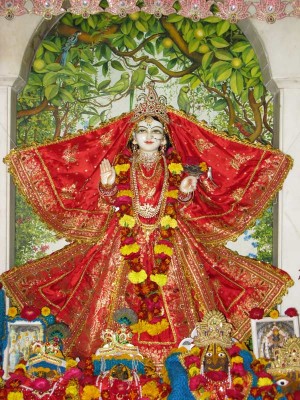
Another name of Tulasi is Vrinda-devi (one who awards residence in Vrindavana). Srila Narottama dasa Thakura says: krpa kori koro tare vrindavana vasi, “Dear Tulasi, please bestow your mercy upon me, so that I may forever reside in Vrindavana.”
The Vrindavana forest is named after Vrinda-devi, who performed penances here for 60,000 years. She was born as the daughter of Emperor Kedera, a very pious king that attained Goloka Vrindavana. His daughter Vrinda-devi, after sanctifying the forest by her penance, also attained Goloka. Ever since, the forest has been known as Vrindavana. Pleased by Vrinda-devi’s austerities Lord Vishnu granted a boon to the Vrindavana forest: “Any penances performed here will quickly fructify and bear excellent results.” Later Tulasi-devi, daughter of King Kusadhvaja, performed penances
here and attained perfection. Tulasi’s second name is Vrinda.
Tulasi Is Dear To Sri Krsna
God has specifically said that among plants, He is the Tulasi (DS chap. 7). Tulasi, Yamuna River and Govardhana Hill are eternally present in the spiritual world. They appear in this world to benefit the living entities by giving love of Godhead. The goddess of fortune is sometimes envious of the Tulasi leaves which are placed at the lotus feet of the Lord, for they remain fixed there and do not move, whereas Laksmiji, although stationed by the chest of the Lord, sometimes has to go to satisfy Her numerous devotees. But the Tulasi leaves never forsake their position, and the Lord therefore appreciates the service of Tulasi more than the service of Laksmi-devi.
The Glories of Tulasi-devi
In the Padma Purana there are thirty chapters describing Tulasi’s appearance. Her glorious attributes are recounted throughout the Vedic literature. “Just by looking at Tulasi, all of one’s sins are removed. Just by touching Her, one’s body becomes purified. All diseases are removed by praying to Her. Fear of death is destroyed by watering Her. Just by planting or transplanting Her, one achieves realization of the Supreme Personality of Godhead. If someone offers Her leaves at the lotus feet of Sri Krsna, Tulasi will award liberation and devotion to Lord Sri Krsna.” (SKP)
Sri Krsna is very fond of Tulasi, also called Maharani. Vayu Purana states: “The Supreme Lord Hari does not accept anyone’s worship without Tulasi.” The poet Candrasekhara says that Krsna does not care for even one of fifty-six offerings or thirty-six curries if they are offered without a Tulasi leaf. “All the places of pilgrimage on this planet and in the millions of universes, take shelter in a Tulasi leaf.” (PP) “Sri Krsna who is very affectionate toward His devotee, sells Himself to devotee who offers merely a Tulasi leaf and a palmful of water.”(CT)
Tulasi And Chanting Japa
“The process of chanting the Hare Krsna maha-mantra with a vow before the Tulasi plant has such strong spiritual potency, that simply by doing this one can become spiritually strong.” (CC Antya 3.lOOp.)
A Prayer
On Srimati Tulasi-devi’s appearance day (the full moon day in Kartik month), Sri Krsna Himself worships Her with the mantra: krsna-jivani, nandini, puspasara, tulasi, visvapavani, visvapujita, vrnda, vrndavani.
Tulasi is the life of Krsna and She gives unlimited bliss to the devotees. She is the best of all the flowers and Her presence is required on any garland to be worn by Krsna. She is one who has no comparison. Tulasi purifies the three worlds and is worshiped all over the universe. Tulasi is the goddess of all plants and trees and She first manifested in Vrindavana.” (PP) One who remembers this mantra will very quickly attain devotion for Sri Krsna.
Srimati Vrinda-devi
“Krsna’s attractive features are also described by Vrinda, the gopi 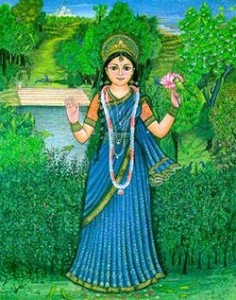 after whom Vrindavana was named. (NOD chap. 26) Vrinda-devi is an expansion of Srimati Radharani and Her partial expansion is Tulasi in Vaikuntha. Vrinda-devi is a very intimate associate and girlfriend of Srimati Radharani. Krsna expands as Narayana to marry Tulasi in one of His pastimes.” (SVMP)
after whom Vrindavana was named. (NOD chap. 26) Vrinda-devi is an expansion of Srimati Radharani and Her partial expansion is Tulasi in Vaikuntha. Vrinda-devi is a very intimate associate and girlfriend of Srimati Radharani. Krsna expands as Narayana to marry Tulasi in one of His pastimes.” (SVMP)
Vrnda-devi has a beautiful complexion the color of molten gold. She wears blue garments and is decorated with pearls and flowers. Her father is Candrabhanu and Her mother is Phullara-devi. Her husband is Mahipala and Her sister is Manjari-devi. She always remains in Vrindavana, immersed in love for Radha and Krsna and yearning to both arrange for Their meeting and taste the nectar of assisting in Their transcendental pastimes. (Sri Sri Radha-Krsna-ganoddesa-dipika)
The Arranger
As the embodiment of the lila-shakti (pastime potency) Vrinda-devi is the organizer of all the transcendental pastimes of Sri Sri Radhika-Krsnacandra. Vrinda keeps many storerooms throughout the forests of Vrindavana. She is always busy, along with Her maidservant and forest goddesses, working to bring the pastimes of Radha-Govinda to complete fulfillment.
“According to the Goswamis, Vrinda-devi has a very unique and elevated position in Sri Sri Radha-Krsna’s pastimes. She arranges the secret and intimate meetings and is a very close associate of Srimati Radhika.” (SVMP) “There are twelve enchanting sporting groves in Vrindavana. Under the instructions of Paurnamasi (personified Yogamaya) Vrinda-devi makes all arrangements for the union of Radha and Krsna, because She is in charge of the forest.” (CS)
The Expert Services of Vrinda-devi
Vrinda-devi is responsible for waking up Radha and Krsna while they are resting in the forest kunjas (groves). She hurries the Divine Couple to Their homes in Nandgaon and Yavat before the sunrise and Their superiors detect Their absence. On Radha’s behalf Vrinda-devi delivers love notes and hand-made gifts, flower earrings and garlands to Sri Krsna. Vrinda arranges all the paraphernalia used in Radha-Krsna’s pastime. She provides all the swings, musical instruments, water-syringes and colour for squirting, clothing, ornaments and a variety of food and drinks.
Together with Her many maidservants, Vrinda-devi, using artistic craftsmanship, tastefully decorates the groves and bowers where Radha and Krsna sport. She engages two expert female parrots to act as spies on the path to alert of the approach of the two spoil-sports, Jatila (Radha’s mother-in-law) and Chandravali (Radha’s rival). When Radha reaches the rendezvous place, Vrinda personally escorts Her to meet Shyamasundara.
During the night rasa dance Vrinda-devi distributes a variety of percussion, stringed and wind instruments to the gopis. Their expert playing creates a celestial concert of scintillating sensations. To relieve the fatigue of the rasa performers Vrinda presents pleasingly prepared plates of delicious forest fruits and golden pots of refreshing honey-nectar.
“Filled with a great flood of love and decorating the ever blossoming groves of Vrindavana with many fragrant flowers, Vrinda-devi creates a festive atmosphere for Sri Sri Radha-Krsna to engage in transcendental pastimes with Their dear friends. Let me surrender to Vrinda-devi.” (VVS)
The Marriage of Vrinda-devi
“Vrindavana is the land of Vrinda-devi, for She is the queen of all the 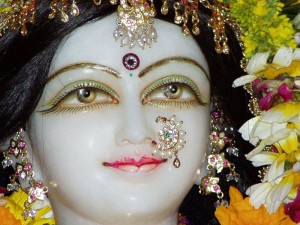 properties, the proprietor of Vrindavana. In one pastime She offered all of Her kingdom of Vrindavana to the lotus feet of Srimati Radharani. Hence, Sri Radha became known as Vrindavanesvari (the queen of Vrindavana) and Lord Krsna is the actual king.
properties, the proprietor of Vrindavana. In one pastime She offered all of Her kingdom of Vrindavana to the lotus feet of Srimati Radharani. Hence, Sri Radha became known as Vrindavanesvari (the queen of Vrindavana) and Lord Krsna is the actual king.
Appreciating Vrinda-devi’s kindness in making wonderful arrangements for Her loving pastimes with Krsna, Srimati Radhika once summoned Lalita-sakhi and Visakha-sakhi and made a plan to reciprocate with Vrinda-devi. Radha and Her friends fashioned a beautiful throne big enough for two people to sit on. Visakha then sat Krsna beside Vrinda-devi. Playing the role of a priest, Lalita-sakhi began chanting the mantras for invoking marriage. Sri Radha personally exchanged the flower garlands between Krsna and Vrinda-devi, and so this wonderful “wedding ceremony” was performed.” (SVMP)
The Mercy of Srimati Vrinda-devi
“Vrindavana is completely under Vrinda-devi’s grace.” (SKP) Without the mercy of Vrinda-devi it is not possible to enter into the confidential pastimes of Radha and Krsna, not even as a listener in an audience. By the mercy of Vrinda-devi even the impossible can become possible. Even being allowed to enter Sri Vraja Mandala indicates that one has received the grace of Vrinda-devi.” (SVMP)
Until recently in Vrindavana Vrinda-devi was worshiped in two places: Kamyavana and Vrinda-kunda. A third deity has appeared to receive wonderful service from the sincere devotees at the Rupa-Sanatana Gaudiya Math Mandir in Seva Kunja, Vrindavana. Whenever one takes the auspicious darsan of Vrinda-devi, he should beg for the mercy to eternally reside in Sri Vraja-dhama as a servant of the servant of the maidservants of Srimati Radhika-Krsnacandra.
Sri Vrindavana Sevamrita
Quoting Prahlada Maharaja, Srila Prabhupada advises that “If one is 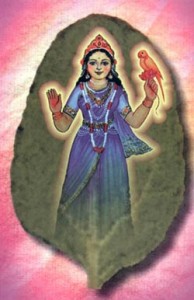 seeking peace of mind he should free himself from all contamination of family life and take shelter of the Supreme Godhead by going to the forest. To the Gaudiya Vaisnava,” Prabhupada explains, “this forest is the forest of Vrinda, or Vrindavana. If one takes shelter of Vrindavana under Vrindavanesvari, Srimati Radharani, certainly all the problems of his life are solved very easily.” (Srimad-Bhagavatam 4.8.24 Purport)
seeking peace of mind he should free himself from all contamination of family life and take shelter of the Supreme Godhead by going to the forest. To the Gaudiya Vaisnava,” Prabhupada explains, “this forest is the forest of Vrinda, or Vrindavana. If one takes shelter of Vrindavana under Vrindavanesvari, Srimati Radharani, certainly all the problems of his life are solved very easily.” (Srimad-Bhagavatam 4.8.24 Purport)
How to take shelter of Krishna in Vrindavana has been demonstrated by Srimati Radharani Herself and the Garga-samhita has recorded the story for our edification.
One time, desiring to know what kind of worship would please Krishna, Srimati Radhika approached Her friend Candranana, the best of the knowers of religion. After reflecting for a moment Candranana informed Srimati Radhika that Lord Krishna’s association could be achieved through serving Tulasi in nine ways:
1) gazing at Her
2) touching Her
3) remembering Her
4) glorifying Her
5) bowing down before Her
6) offering prayers to Her
7) planting Her
8) watering Her and worshiping Her
The astounding results of serving Tulasi in such ways include guaranteed residence in Lord Krishna’s transcendental abode for as many ancestors and descendants as there are branches, sub-branches, seeds, flowers and leaves on the Tulasi a person has planted. Candranana also informed Srimati Radhika that by offering Lord Krishna a single Tulasi leaf one attains the result of offering Him every flower and leaf that exists and that a person who worships Krishna with offerings of Tulasi leaves is not touched by sin. Candranana further said that Yamaraja’s servants will never enter a home in the midst of a Tulasi forest.
The Importance of Worshiping Tulasi-devi
All the famous acaryas in our disciplic succession emphasize the importance of worshiping Tulasi. Srila Bhaktisiddhanta Sarasvati Thakura, the spiritual master of our Srila Prabhupada, commented that “Srimati Tulasi Maharani is our spiritual master. She is the queen of Sri Vrindavana Dhama. It is only by Her mercy that one can be qualified to enter in Sri Vrindavana Dhama. We wear Tulasi Maharani around our neck, knowing that She is very dear to Lord Krishna. By our allegiance to Her, we chant the name of Lord Hari.”
In his poem titled Sri Sankalpa-kalpadruma,
Srila Visvanatha Cakravarti Thakura has prayed:
vrindavana-sthira-caran paripalayitri
vande tayo rasikayor ati-saubhagena
adhyasi tat kuru krpam ganana yathaiva
sri-radhika-parijanesu mamapi siddhet
O Vrinda-devi, O protectress of the moving and non-moving living entities in Vrindavana, you are wealthy in the mercy of the Divine Couple who enjoy pastimes in Vraja. Please be merciful to me. Please place me among Sri Radha’s associates.
he sri-tulasy uru-krpa-dyu-tarangini tvam
yan murdhni me carana-pankajam adadhasvam
yac caham apy apibam ambu manak tadiyam
tan me manasy udayam eti manoratho’yam
O Srimati Tulasi-devi, O celestial Ganges river of mercy, it is because I once placed my head at your lotus feet and drank some drops of water that washed your lotus feet, that these desires have risen in my heart.
kvaham parah sata-nikaty-anuviddha-cetah
sankalpa esa sahasa kva su-durlabhe’rthe
eka kalpaiva tava mam ajahaty upadhi-
sunyeva mantum adadhaty agater gatir me
O Srimati Tulasi-devi, how low I am, my heart pierced by hundreds of offenses! How exalted and difficult to attain is my aspiration! Your causeless mercy is my only hope. It is by Your mercy that I, who am so fallen, can have these desires in my thoughts.
The Caitanya Bhagavata states that Sri Caitanya Mahaprabhu’s disciples would keep a Tulasi tree beside Him. The Lord would sit, taking darshan of Srimati Tulasi Maharani and chant His prescribed number of rounds. “Just as a fish cannot live when taken out of water, so I cannot remain alive in separation of Tulasi Maharani,” Sri Caitanya Mahaprabhu used to say.
In his Sri Sri Radha-Krishna-Ganoddesha-Dipika, Srila Rupa Gosvami describes Vrinda-devi as the best of Krishna’s gopi messengers. The gopi messengers expertly know the geography of Vrindavana and they intimately know each grove and garden there. They are also learned in the science of gardening.
All the gopi messengers are filled with great love for Sri Sri Radha and 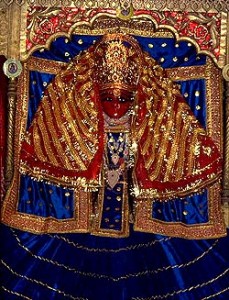 Krishna, but among them, Vrinda-devi is the best. She has a beautiful complexion, like molten gold, wears blue garments, and is decorated with pearls and flowers. Srila Raghunatha Dasa Gosvami has explained in VRAJA VILASA STAVA that “Vrinda-devi is the transcendental orchestrator of Radha-Krishna’s pastimes. She decorates the pastime groves and creates a festive atmosphere to enhance the divine couple’s pleasure.” She is expert at arranging the meeting of Radha and Krishna, and She knows the best places for the Divine Couple’s rendez-vous. Flowers, creepers, vines and trees are under Her supervision, and all the birds and animals in Vrindavana carry out Her orders. Her chief disciple, the yellow parrot Daksa, resides upon Her left hand. From there he sends the other one hundred thousand parrot disciples flying all over Vraja to deliver Vrinda-devi’s messages or warnings of unforeseen events.
Krishna, but among them, Vrinda-devi is the best. She has a beautiful complexion, like molten gold, wears blue garments, and is decorated with pearls and flowers. Srila Raghunatha Dasa Gosvami has explained in VRAJA VILASA STAVA that “Vrinda-devi is the transcendental orchestrator of Radha-Krishna’s pastimes. She decorates the pastime groves and creates a festive atmosphere to enhance the divine couple’s pleasure.” She is expert at arranging the meeting of Radha and Krishna, and She knows the best places for the Divine Couple’s rendez-vous. Flowers, creepers, vines and trees are under Her supervision, and all the birds and animals in Vrindavana carry out Her orders. Her chief disciple, the yellow parrot Daksa, resides upon Her left hand. From there he sends the other one hundred thousand parrot disciples flying all over Vraja to deliver Vrinda-devi’s messages or warnings of unforeseen events.
Nandagram, the eternal residence of Nanda Maharaja, is built on Nandisvara Hill. Vrinda-devi’s place, Vrinda-kunda, is at the foot of Nandisvara Hill, near Pavana Sarovara, where Srimati Radharani comes every morning to cook Krishna’s breakfast. Meanwhile, Krishna and Balarama milk the cows, and Paurnamasi, the guru of Vraja, meets Vrinda-devi at Her place to plan the Divine Couple’s pleasure pastimes for that day. For each of the eight-fold daily pastimes of Radha and Krishna Vrinda-devi makes elaborate arrangements for an appropriate forest spot and specific trees, creepers, fruits, flowers, birds and other animals. She personally selects the various color combinations, fragrances, songs and musical instruments to be offered for the pleasure of Radha and Krishna; and She decides who, among the unlimited number of gopis and manjaris, will assist Lalita and Visakha offer sandalwood pulp, serve refreshments, play musical instruments, fan the Divine Couple with camaras, and offer pan, betel nuts and spices on a jeweled tray. Every single detail of each and every one of Radha and Krishna’s eight fold daily pastimes–which peacocks will dance, which bumble bees will hum, which parrots and kokilas will sing, which breezes will blow–is engineered by Vrinda-devi.
After Krishna and Balarama finish Their morning meal, They go to to the forests of Vrindavana to tend Their cows with Their cowherd boyfriends, while Srimati Radharani and Her associates walk back to Her home in Yavat. On the way Srimati Radhika stops at Vrinda-kunda and secretly meets Krishna there, at the spot named Gupta-kunda. (Gupta means secret.) Since Gupta-kunda is the first daily meeting place of Radha and Krishna, the residents of Vrindavana refer to that place as a “Yoga-pitha,” or a center of eternal pastimes.
From dawn to sunrise, Vrinda-devi lovingly engages in the service of the Divine Couple. It is She who prepares Their bed of flowers at night, She who wakes Them up and sends Them to Their respective homes before sunrise. Her love for Them is unlimited.
Another famous and respected gopi messenger in Vraja is Vira-devi. She can be very bold and arrogant, but She can also speak sweet and flattering words, as Vrinda-devi does. Her complexion is dark and She wears splendid white garments and various jewels and flower garlands. Vira-devi resides at the corner of Gupta-kunda behind Vrinda-kunda. By the mercy of Her follower Sri Madhava dasa Baba, Vrinda-kunda and Gupta-kunda were rediscovered less than fifty years ago and subsequently handed over to the care of ISKCON.
Quotation: Chaitanya Charitamrita Madhya Lila chapter 24 Verse 261
tulasi-parikrama kara, tulasi-sevana
nirantara krsna-nama kariha kirtana
tulasi-parikrama kara-circumambulate the Tulasi plant; tulasi-sevana-just supply water to the root of Tulasi-devi; nirantara-continuously; krsna-nama-the holy name of Krsna; kariha-just perform; kirtana-chanting.
After planting the Tulasi tree before your house, you should daily circumambulate that Tulasi plant, serve Her by giving Her water and other things, and continuously chant the Hare Krsna maha-mantra.
Quotation by Srila Visvanatha Cakravarti:|
Tulasi, although exalted in many ways, is not normally considered an especially fragrant plant. However, early in the morning Tulasi emits a transcendental fragrance that ordinary people cannot perceive but that transcendental personalities fully appreciate. The bees who are privileged to swarm about the flower garlands worn by the Supreme Personality of Godhead certainly appreciate this fragrance, and Srila Visvanatha Cakravarti quotes from the Bhagavatam (3.15.19) to the effect that the most fragrant plants in Vaikuntha also appreciate the special qualifications of Tulasi-devi.
The Glories of Tulasi-devi
(from the “Pancaratra Pradipa”, a manual on Deity Worship, authorized by the GBC body of ISKCON)
As quoted from Vedic scripture in the Vaisnava work ” Nectar of Devotion “(Bhakti-rasamrta-sindhu) by Srila Rupa Gosvami:
“Let me offer my respectful obeisances unto the Tulasi tree, which can immediately vanquish volumes of sinful activities. Simply by seeing or touching this tree, one can become relieved from all distresses and diseases. Simply by offering obeisances to and pouring water on the Tulasi tree, one can become freed from the fear of being sent to the court of Yamaraja.
If someone sows a Tulasi tree somewhere, certainly he becomes devoted to Lord Krishna. And when the Tulasi leaves are offered in devotion at the lotus feet of Krishna, there is the full development of love of Godhead.” (from the Skanda Purana, as quoted by Srila Rupa Gosvami)
Tulasi is glorified throughout the Puranas and Pancaratra: It was for the spiritual upliftment of the souls in the material world that Lord Visnu created Tulasi as the ocean of milk was being churned. Tulasi is more dear to the Lord than Laksmi, for Tulasi-devi undertook extreme austerities and worshiped the Lord with love in order to have Him as Her husband, and the Lord fulfilled Her wish.
“There is no better recipient of charity than a vipra, no better gift than cows, no better tirtha than the Ganga, and no better leaf than a Tulasi leaf. Whatever one can obtain by offering the Lord all types of flowers and leaves may be attained by simply offering Him one Tulasi leaf. An offering of flowers made of gold, jewels, and pearls is not equal to an offering of Tulasi leaves.”
“By offering the Lord Tulasi leaves, a devotee is released from sins accumulated for one koti (ten million) lifetimes. When a devotee offers Tulasi to the Lord’s head, all the devotee’s unmentionable and undetected sins are destroyed. By sprinkling the Lord’s house with water using a Tulasi leaf, one is freed from all great sins. A person who has Tulasi leaves in his mouth or on his head or body when he dies is guaranteed not to suffer in hell.”
The Benefits of Rendering Service To Srimati Tulasi-devi
nirmita tvam pura devair arcita tvam surasuraih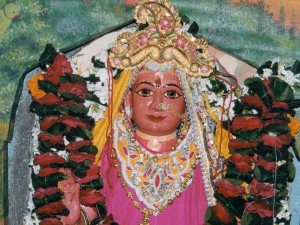
tulasi hara me papam pujam grhna namostute
(Hari Bhakti Vilasa 9/101 from Skanda Purana)
Oh Tulasi, you previously appeared in this world due to the demigods. The demigods and demons together worship you. Please remove all of my sins. I pay my obeisances unto you.
NOTE: Anyone who has received initiation in the Vaishnava mantras is obliged to engage in regular worship of the Deity, including offering all he eats to the Lord. When devotees make such food offerings, they should remember to place Tulasi leaves or flowers on them because Lord Vishnu does not accept any food without Tulasi. Tulasi is most beloved of Lord Krishna and thus Her leaves and flowers are also most dear to Him. The term varknarcavatara meaning the Lord’s incarnation meant for accepting worship (arcavatara) in the form of a tree (varkna) is applied to Tulasi-devi. Her leaves and flowers are therefore prescribed as an essential part of the worship of the Lord’s other arcavatara, i.e., the deity form of the Lord in the temple. These regulations are found in all the scriptural texts that describe the procedures by which one is to worship such deity forms of the Lord.”
Srila Bhaktisiddhanta Sarasvati Thakura, Gaudiya Bhasya.
ya drsta nikhila agha sangha samani sprsta vapuh pavani
roganam abhivandita nirasini siktantaka trasini
pratya satti vidhayini bhagavatah krsnasya samropita
nyasta taccarane vimukti phalada tasyai namah
(Hari Bhakti Vilasa 9/104 from Skanda Purana, Avanti khanda)
Just by looking at you (Tulasi), all sins become removed. Just by touching you, one’s body becomes pure. By praying to Her, all diseases practically become removed. If one waters Her or makes Her wet, the fear of Yamaraja (death personified) is destroyed. Just by planting or transplanting, one achieves nearness to the Supreme Personality of Godhead. If someone offers Tulasi at the lotus feet of Lord Sri Krsna, She awards liberation and devotion to Him, therefore I pay my humble obeisances to such a wonderful Tulasi-devi.
pradaksinam bhramitva ye namaskurvanti nityasah
na tesam duritam kincid aksinam avasisyate
(Hari Bhakti Vilasa 9/111 from Agastya samhita)
If someone daily goes around Tulasi and pays obeisances to Her, there is no more sin to be destroyed in him.
hitva tirtha-sahasrani sarvan api siloccayan
tulasi kanane nityam kalau tisthati kesavah
(Hari Bhakti Vilasa 9/116 from Skanda Purana)
In Kali-yuga, Lord Sri Kesava, after giving up thousands of places of pilgrimage and holy days, He resides in the forest of Tulasi-devi.
drstva sprstva tatha dhyata kirtita namita srta
ropita sevita nityam pujita tulasi subha
navadha tulasim nityam ye bhajanti dine dine
yuga koti sahasrani te vasanti harer grhe
(Hari Bhakti Vilasa 9/126,127 from Skanda Purana, conversation between Lord Brahma and Narada Muni)
Any person who daily sees Tulasi, touches Tulasi, chants Tulasi’s prayers, meditates on Tulasi, pays obeisances to Her, hears about Her, transplants, waters and worships Her, he achieves all auspiciousness. Any person who does these nine kinds of service goes to the abode of the Supreme Lord Hari and remains there eternally.
snane dane tatha dhyane prasane kesava arcane
tulasi dahate papam ropane kirtane kalau
(Hari Bhakti Vilasa 9/132 from Skanda Purana, Avanti khanda)
In Kali-yuga Tulasi-devi burns up all of a person’s sins who bathes Her, gives Her in charity, meditates on Her, eats Her leaves, worships Lord Sri Kesava with Her, transplants Her or sings Her glories.
tulasy alankrta ye ye tulasi nama japakah
tulasi vana palaye te tyajya durato bhatah
(Hari Bhakti Vilasa 9/133 from Skanda Purana, Kasi khanda, Yamaraja instructs his messengers)
Oh messengers, anybody who is decorated with Tulasi wood or chants Her name, always protects a Tulasi forest, you should give up bringing such persons to my abode.
darsanam narmadayas tu ganga snanam visam vara
tulasi dala samsparsah samam etat trayam smrtam
ropanat palanat sekad darsanat sparsanat nrnam
tulasi dahate papam vaca manah kaya sancitam
(Hari Bhakti Vilasa 9/139,140 from Padma Purana)
Oh best of the Vaisyas, seeing Narmada, taking bath in the Ganges, and touching Tulasi leaves are equally meritorious. If somebody plants, protects, waters, sees or touches Tulasi, then that person’s sins acquired by body, mind and words are burnt into ashes.
yad grhe tulasi bhati raksabhir jalasecanaih
tad grham yama dutas ca durato varjayanti hi
(Hari Bhakti Vilasa 9/145 from Padma Purana, Kartika mahatmya)
In any house where Tulasi Maharani is very carefully protected and watered, the messengers of Yamaraja give up that house from a distance.
visnos trailokya nathasya ramasya janakatmaja
priya tathaiva tulasi sarva lokaika pavani
(Hari Bhakti Vilasa 9/151 from Agastya samhita)
As the daughter of Janaka, Sri Sitadevi, is very dear to Lord Rama, the master of the three worlds, similarly, Tulasi-devi, who purifies all of the planets, is very dear to Him.
tulasi vapita yena punyarame vane grhe
paksindra tena satyoktam lokah sapta pratisthitah
(Hari Bhakti Vilasa 9/157 from Garuda Purana)
Oh king of the birds (Garuda), anyone who has planted a garden of Tulasi, either in the forest or in the house, I truthfully say that he has won the seven planetary systems.
sansara-papa vicchedi ganga nama prakirtitam
tatha tulasya bhaktis ca hari kirti pravaktari
(Hari Bhakti Vilasa 9/161 from Brhan Naradiya Purana)
As by chanting the name of Ganges, one becomes free from all kinds of worldly sins, if someone chants the name of Tulasi or chants the glories of Lord Hari with devotion, he gets the same merit.
trnani tulasi mulat yavantyapahinoti vai
tavattir brahma hatya hi chinaty eva nasamsayah
(Hari Bhakti Vilasa 9/165 from Brhan Naradiya Purana, conversation between Yamaraja and Bhagiratha)
Anybody who removes the straw or dirt from the root of a Tulasi-devi, as many as he has removed, that many sinful reactions of killing brahmanas will be removed from him without a doubt.
durlabha tulasi seva durlabha sungatih satam
durlabha hari bhaktis ca sansararnava-patinam
(Hari Bhakti Vilasa 9/170 from Brhan Naradiya Purana)
Those people who have fallen in the midst of this material world, among them worship of Tulasi is very rare, the association of real saintly persons is very rare, and real devotion to Lord Hari is also very rare.
yasmin grhe dvija srestha tulasimula mrttika
sarvada tisthate dehe devata na sa manusa
tulasi mrttika yatra kastham patran ca vesmani
tisthate muni sardula niscalam vaisnava padam
(Hari Bhakti Vilasa 9/183,186 from Skanda Purana, conversation between Lord Brahma and Narada Muni)
Oh best among the brahmanas, in anybody’s house or on his body, if the mud from Tulasi is available, they are not just men, but they are equal to the demigods. Oh best among the sages, in anyone’s house, if there is the clay of Tulasi, Tulasi wood, and Tulasi leaves available, that house is certainly a place of Lord Visnu.
tulasi mula sambhuta hari bhakta padodbhava
gangodbhava ca mrllekha nayaty acyuta rupatam
(Hari Bhakti Vilasa 9/189)
Any person who puts on tilaka from the mud or clay from the root of Tulasi, mud from the lotus feet of Sri Vaisnava, and mud from the Ganges is said to be equal to the form of Lord Sri Visnu.
patram puspam phalam kastham tvat sakha-pallavankuram
tulasi sambhavam mulam pavanam mrttikady api
(Hari Bhakti Vilasa 9/191 from Prahlada samhita and Visnu dharmottara)
Leaves of Tulasi, flowers of Tulasi, fruits of Tulasi, branches of Tulasi, bark of Tulasi, sprout of Tulasi, blossom or bud of Tulasi, and clay of Tulasi are all completely purified.
yah kuryat tulasi kasthair aksa malam surupinim
kantha malam ca yatnena krtam tasyaksayam bhavet
(Hari Bhakti Vilasa 9/199 from Skanda Purana, Agastya samhita, conversation between Lord Brahma and Narada Muni)
Any person who makes a beautiful japamala or neck beads out of Tulasi wood and uses them, if he does not perform any worship to Lord Sri Visnu, all of his activities become unlimitedly resultful.
yasya nabhi sthitam patram mukhe sirasi karnayoh
tulasi sambhavam nityam tirthais tasya makhais ca kim
(Hari Bhakti Vilasa 9/200 from Skanda Purana, conversation between Lord Brahma and Narada Muni)
If anyone daily has Tulasi leaves on his navel, in his mouth, on his head, or on both of his ears, what is the use of him going to the places of pilgrimage in this world?
yah kascit vaisnavo loke mithyacaro’py anasrami
punati sakalan lokan sirasa tulasim vahan
(Hari Bhakti Vilasa 9/202 from Skanda Purana)
If any Vaisnava in this world becomes a liar or becomes degraded from his own asrama, if he has a Tulasi leaf on his head, he can alone purify the three worlds.
Srila Sanatana Gosvami gives his Digdarsani-tika commentary on this verse, stating that if Vaisnavas wear articles which have been offered to the Supreme Lord, then one may question how a Vaisnava can wear something which has not been offered to the Supreme Lord. In answer to this, it can be stated that only a lying or cheating “Vaisnava” can do such a thing because they are all hypocrites and not real Vaisnavas.
bhaksitam lubdhakenapi patram tulasi sambhavam
pascad distantam apanno bhasmi bhutam kalevaram
sita sitam yatha niram sarva papa ksayavaham
tatha ca tulasi patram prasitam sarva kamadam
(Hari Bhakti Vilasa 9/213,214 from Skanda Purana, conversation between Vasistha and King Mandhata)
Even if a most sinful hunter eats a Tulasi leaf and dies afterwards, whatever sins he has in his body turn into ashes. As whitish and blackish water (Ganges and Yamuna water) remove all kinds of sins, in the very same way white (green) and black Tulasis removes all kinds of sins, and if he eats these leaves (after offering them to Lord Krsna), all of his desires are perfectly achieved.
krtva papa sahasrani purve vayasi manavah
tulasi bhaksanan mucyet srutam etat pura hareh
(Hari Bhakti Vilasa 9/218 from Skanda Purana, conversation between Vasistha and King Mandhata)
If any person in his young age commits thousands of sins but later on eats a Tulasi leaf, he becomes free from all sins. This narration was heard previously near Lord Sri Hari.
kim citram asyah patitam tulasya
dalam jalam va patitam punite
lagnadi bhala sthalam alavala
mrtsnapi krtsna agha vinasanaya
srimat tulasyah patrasya mahatmyam yadyapi drsam
tathapi vaisnavas tan na grahyam krsnarpanam vina
(Hari Bhakti Vilasa 9/226,227)
What can I say about the wonderful glories of Tulasi? Her fallen leaves, Her rotten leaves and Her water, even if fallen (mixed with Her mud?) is purifying. If even a minute quantity of the mud which has emanated from the Tulasi root has been placed on one’s head, all of one’s sins are removed. Although Tulasi is so glorious (and Her leaves are so purifying), still Vaisnavas never eat Tulasi leaves without first offering them to the Supreme Personality of Godhead, Krsna.
